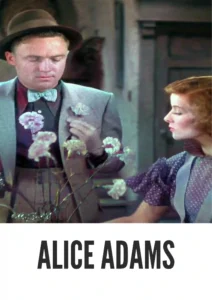Video Sources 0 Views

Synopsis
Social Aspirations and Romance: Alice Adams (1935) in Stunning Color

Delve into the heartwarming story of Alice Adams, a romantic drama from 1935, beautifully colorized for a fresh viewing experience. Starring Katharine Hepburn and Fred MacMurray, this film explores themes of social class, family, and love in a charming small-town setting. Perfect for fans of classic cinema and those who appreciate timeless stories, this HD download brings a beloved film to life with vibrant color and detail.
Alice Adams Storyline: A Young Woman’s Quest for Acceptance
Alice Adams follows the story of Alice (Katharine Hepburn), a young woman from a modest family who dreams of climbing the social ladder in her small town. Despite her best efforts, Alice often finds herself overshadowed by the wealthier and more established families.Determined to improve her family’s social standing, Alice navigates the complexities of love and social expectations. Her aspirations lead her to a series of humorous and sometimes heartbreaking situations as she tries to impress the town’s elite. When she meets Arthur Russell (Fred MacMurray), a charming and wealthy newcomer, Alice sees an opportunity to achieve her dreams. However, her insecurities and the disapproval of Arthur’s family threaten to derail her plans. The film culminates in Alice making a pivotal decision about her future, choosing between social ambition and genuine happiness. Alice Adams is a touching and insightful story about self-discovery and the true meaning of success.
Movie Cast
The film features a talented cast of actors who bring this heartwarming story to life:
- Katharine Hepburn as Alice Adams
- Fred MacMurray as Arthur Russell
- Fred Stone as Virgil Adams
- Evelyn Venable as Mildred Palmer
- Frank Albertson as Walter Adams
Movie Genre
Alice Adams falls into the genre of romantic drama, with elements of comedy and social commentary that are characteristic of classic Hollywood cinema. Its focus on character development, emotional depth, and societal themes makes it a captivating and thought-provoking film.
Historical Context: Classic Hollywood and Social Commentary
Released in 1935, Alice Adams reflects the social and economic realities of the Great Depression era, exploring themes of class disparity and the pursuit of the American Dream. The film was produced during a period when Hollywood studios were creating socially conscious films that resonated with audiences facing economic hardship. Alice Adams stands out for its sensitive portrayal of a young woman’s struggles and its nuanced commentary on social expectations.
Colorization Details
This colorized version of Alice Adams has been meticulously restored using modern digital techniques, enhancing the visual appeal while preserving the film’s original charm and emotional depth. The colorization process involved carefully analyzing the grayscale tones of the original black and white footage and assigning appropriate colors to each scene. While the specific software used remains proprietary, the techniques employed included advanced algorithms for color palette selection and image enhancement. This painstaking process brings new life to the characters and settings, making the story even more engaging for modern audiences. While some may debate the merits of colorizing classic films, it introduces these films to a broader audience, ensuring their legacy for future generations.
Technical Details
- Director: George Stevens
- Screenplay: Dorothy Yost, Mortimer Offner
- Based on: the novel by Booth Tarkington
- Cinematography: Robert De Grasse
- Edited by: Jane Loring
- Production Company: RKO Radio Pictures
- Distributed by: RKO Radio Pictures
- Runtime: 99 minutes
Technical Specifications
- Download Format: MP4
- Resolution: HD (1080p)
- Compatibility: Compatible with most devices, including smartphones, tablets, computers, and smart TVs.
Reviews and Critical Reception
Alice Adams (1935) is highly regarded for its sensitive storytelling, strong performances, and insightful social commentary. Katharine Hepburn’s portrayal of Alice Adams is considered one of her finest performances, earning her an Academy Award nomination. The film’s exploration of class dynamics and the pursuit of happiness continues to resonate with audiences today. As a timeless classic, Alice Adams offers a compelling glimpse into the social and emotional landscape of 1930s America.
FAQs
- Q: What is Alice Adams about?
- A: Alice Adams is a romantic drama about a young woman from a modest family who dreams of climbing the social ladder in her small town.
- Q: Is Alice Adams (1935) a well-known Katharine Hepburn film?
- A: Yes, Alice Adams is one of Katharine Hepburn’s most acclaimed performances, earning her an Academy Award nomination.
- Q: Is this version of Alice Adams colorized?
- A: Yes, this version has been professionally colorized to enhance the viewing experience.
- Q: What makes Alice Adams interesting for classic film fans?
- A: Alice Adams offers a compelling glimpse into the social and emotional landscape of 1930s America, with strong performances and insightful social commentary.
- Q: What is the download format?
- A: The download format is MP4, which is compatible with most devices.
- Q: What resolution is the download?
- A: The resolution is HD (1080p), providing a high-quality viewing experience.
Download Now in HD!
Watch Alice Adams Today!












